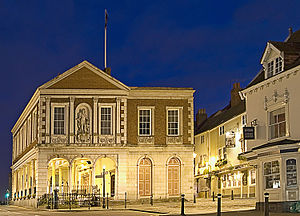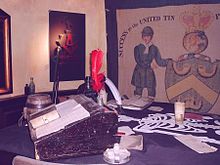- Guild
-
For other uses, see Guild (disambiguation).
A guild (German: Gilde) is an association of craftsmen in a particular trade. The earliest types of guild were formed as confraternities of workers. They were organized in a manner something between a trade union, a cartel, and a secret society. They often depended on grants of letters patent by a monarch or other authority to enforce the flow of trade to their self-employed members, and to retain ownership of tools and the supply of materials. A lasting legacy of traditional guilds are the guildhalls constructed and used as meeting places.
An important result of the guild framework was the emergence of universities at Bologna, Paris, and Oxford around the year 1200; they originated as guilds of students as at Bologna, or of masters as at Paris.[1]
The economic consequences of guilds have led to heated debates among European historians. Ogilvie (2008) argues that their long apprenticeships were unnecessary to acquire skills, and their conservatism reduced the rate of innovation and made the society poorer. She says their main goal was rent seeking, that is, to shift money to the membership at the expense of the entire economy.[2] Epstein and Prak's book (2008) rejects Ogilvie's conclusions.[3] Specifically, Epstein argues that guilds were cost-sharing rather than rent-seeking institutions. They located and matched masters and likely apprentices through monitored learning. Whereas the acquisition of craft skills required experience-based learning, he argues that this process necessitated many years in apprenticeship.[4]
Contents
Early guildlike associations
In pre-industrial cities, craftsmen tended to form associations based on their trades, confraternities of textile workers, masons, carpenters, carvers, glass workers, each of whom controlled secrets of traditionally imparted technology, the "arts" or "mysteries" of their crafts. Usually the founders were free independent master craftsmen.
During the Gupta period in India (AD 300–600), craftmen's associations, which may have had archaic antecedents, were known as shreni. Greek organizations in Ptolemaic Egypt were called koinon, starting from their 3rd century BC origins of Roman collegia, spread with the extension of the Empire. The Chinese hanghui probably existed already during the Han Dynasty (206 BC - AD 220):, but certainly they were present in the Sui Dynasty (589 - 618 AD). Roman craftsman's organizations continued to develop in Italy of the Middle Ages under the name ars. In Germany they are first mentioned in the 10th century. The German name is Zunft (plural Zünfte) for guilds of craftsman and Gilde (plural Gilden) for guilds of merchants. Métiers in France and craft gilds in England emerged in the 12th century. Craft organizations (senf, sinf) stemmed from the 10th century in Iran, and were seen to spread also in Arabia and Turkish regions under the name futuwwah or fütüvvet. 900 of the carvers of Benin are said to have founded their own organization. In the neighbouring tribes of Yoruba and Nupe the organizations were given the names egbe and efakó. Specifically, within the medieval Oyo Empire of present day southwestern Nigeria and Benin, separate guilds developed for professional dancers, mask carvers, and musicians associated with egungun ancestral masquerade performances often regarded as the predecessor to the traveling Alarinjo theatre.[5]
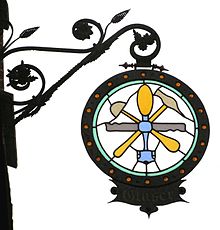 Traditional wrought-iron guild sign of a glazier - in Germany. These signs can be found in many old European towns where guild members marked their places of business. Many survived through time or staged a comeback in industrial times. Today they are newly created or even restored, esp. in old town areas.
Traditional wrought-iron guild sign of a glazier - in Germany. These signs can be found in many old European towns where guild members marked their places of business. Many survived through time or staged a comeback in industrial times. Today they are newly created or even restored, esp. in old town areas.
European history
The word guild (c.1230, yilde) the spelling later influenced by O.N. gildi is a semantic fusion of O.E. gegyld "guild" and gild, gyld "payment, tribute, compensation," from P.Gmc. *gelth- "pay" (cf. O.Fris. geld "money," O.S. geld "payment, sacrifice, reward," O.H.G. gelt "payment, tribute"). The Saxon word gilden meant "to pay".
The connecting sense is of a tribute or payment to join a protective or trade society. But some see the root in its alternative sense of "sacrifice," as if in worship, and see the word as meaning a combination for religious purposes, either Christian or pagan. The Anglo-Saxon guilds had a strong religious component; they were burial societies that paid for masses for the souls of deceased members as well as paying fines in cases of justified crime. The continental custom of guilds of merchants arrived after the Norman Conquest, with incorporated societies of merchants in each town or city holding exclusive rights of doing business there. In many cases they became the governing body of a town (for example, Guildhall became London city hall). Trade guilds arose in the 14th century as craftsmen united to protect their common interest.
The early egalitarian communities called "guilds" (for the gold deposited in their common funds) were denounced by Catholic clergy for their "conjurations"—the binding oaths sworn among artisans to support one another in adversity and back one another in feuds or in business ventures. The occasion for the drunken banquets at which these oaths were made was December 25, the pagan feast of Jul: Bishop Hincmar, in 858, sought vainly to Christianize them.[6]
In the Early Middle Ages, most of the Roman craft organizations, originally formed as religious confraternities, had disappeared, with the apparent exceptions of stonecutters and perhaps glassmakers. Gregory of Tours tells a miraculous tale of a builder whose art and techniques suddenly left him, but were restored by an apparition of the Virgin Mary in a dream. Michel Rouche[7] remarks that the story speaks for the importance of practically transmitted journeymanship.
In France, guilds were called corps de métiers. According to Viktor Ivanovich Rutenburg, "Within the guild itself there was very little division of labour, which tended to operate rather between the guilds. Thus, according to Étienne Boileau's Book of Handicrafts, by the mid-13th century there were no less than 100 guilds in Paris, a figure which by the 14th century had risen to 350."[8] The most striking example of an elaborate classification according to craft is found in the metal-workers: the farriers, knife-makers, locksmiths, chain-forgers, nail-makers, often formed separate and distinct corporations; the armourers were divided into helmet-makers, escutcheon-makers, harness-makers, harness-polishers, etc.[9]
In England, specifically in the City of London Corporation, more than 100 guilds [1], referred to as livery companies have been in existence for over a thousand years. They continue to exist and several still play a role today[10]. Membership in a livery company is expected for individuals participating in the governance of The City, as the Lord Mayor and the Remembrancer. A recent guild is the Worshipful Company of Tax Advisers.
The guild system reached a mature state in Germany circa 1300 and held on in the German cities into the 19th century, with some special privileges for certain occupations remaining today. In the 15th century, Hamburg had 100 guilds, Cologne 80, and Lübeck 70.[11] The latest guilds to develop in Western Europe were the gremios of Spain: e.g., Barcelona (1301), Valencia (1332) and Toledo (1426).
Not all city economies were controlled by guilds; some cities were "free". Where guilds were in control, they shaped labour, production and trade; they had strong controls over instructional capital, and the modern concepts of a lifetime progression of apprentice to craftsman, journeyman, and eventually to widely-recognized master and grandmaster began to emerge. In order to become a Master, a Journeyman would have to go on a 3 year voyage called Journeyman years. This was also known as the Waltz and is the origin of the Australian song Waltzing Matilda[citation needed]. The practice of the Journeyman years still exists in Germany.
As production became more specialized, trade guilds were divided and subdivided, eliciting the squabbles over jurisdiction that produced the paperwork by which economic historians trace their development: there were 101 trades in Paris by 1260,[12] and earlier in the century the metalworking guilds of Nuremberg were already divided among dozens of independent trades, in the boom economy of the 13th century. In Ghent as in Florence the woolen textile industry developed as a congeries of specialized guilds. The appearance of the European guilds was tied to the emergent money economy, and to urbanization. Before this time it was not possible to run a money-driven organization, as commodity money was the normal way of doing business.
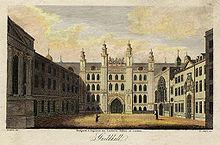 A center of urban government: the Guildhall, London (engraving, ca 1805)
A center of urban government: the Guildhall, London (engraving, ca 1805)
The guild was at the center of European handicraft organization into the 16th century. In France, a resurgence of the guilds in the second half of the 17th century is symptomatic of the monarchy's concerns to impose unity, control production and reap the benefits of transparent structure in the shape of more efficient taxation.[citation needed]
The guilds were identified with organizations enjoying certain privileges (letters patent), usually issued by the king or state and overseen by local town business authorities (some kind of chamber of commerce). These were the predecessors of the modern patent and trademark system. The guilds also maintained funds in order to support infirm or elderly members, as well as widows and orphans of guild members, funeral benefits, and a 'tramping' allowance for those needing to travel to find work. As the guild system of the City of London declined during the 17th century, the Livery Companies transformed into mutual assistance fraternities along such lines.
European guilds imposed long standardized periods of apprenticeship, and made it difficult for those lacking the capital to set up for themselves or without the approval of their peers to gain access to materials or knowledge, or to sell into certain markets, an area that equally dominated the guilds' concerns. These are defining characteristics of mercantilism in economics, which dominated most European thinking about political economy until the rise of classical economics.
The guild system survived the emergence of early capitalists, which began to divide guild members into "haves" and dependent "have-nots". The civil struggles that characterize the 14th century towns and cities were struggles in part between the greater guilds and the lesser artisanal guilds, which depended on piecework. "In Florence, they were openly distinguished: the Arti maggiori and the Arti minori—already there was a popolo grasso and a popolo magro".[13] Fiercer struggles were those between essentially conservative guilds and the merchant class, which increasingly came to control the means of production and the capital that could be ventured in expansive schemes, often under the rules of guilds of their own. German social historians trace the Zunftrevolution, the urban revolution of guildmembers against a controlling urban patriciate, sometimes reading into them, however, perceived foretastes of the class struggles of the 19th century.
In the countryside, where guild rules did not operate, there was freedom for the entrepreneur with capital to organize cottage industry, a network of cottagers who spun and wove in their own premises on his account, provided with their raw materials, perhaps even their looms, by the capitalist who reaped the profits. Such a dispersed system could not so easily be controlled where there was a vigorous local market for the raw materials: wool was easily available in sheep-rearing regions, whereas silk was not.
Organization
The structures of the craftsmen's associations tended everywhere in similar directions: a governing body, assisting functionaries and the members' assembly. The governing body consisted of the leader and deputies. In Ptolemeic Egypt the presidents were known as presbyter, in Roman Egypt as proestotes, egoymenos or archonelates, in Byzantine Egypt epistates, in the Roman Empire as decurio, in Florence of the Middle Ages as consul, officialis or rector, in France as consul, recteur, baile or surposé, in Germany Zunftmeister or Kerzenmeister, in England alderman, graceman or master, in Iran as rish safid or pishavaran, in India as adhyaksha, mukhya, pamukkha or jettaka, in Tibet as dbu chen mo, in China as hangshou, hangtou or hanglao, in the West African Yoruba region as bale or baba egbe and in the Nupe region as dakodza, muku or ndakó, depending on the type of craft.[citation needed]
The guild was made up by experienced and confirmed experts in their field of handicraft. They were called master craftsmen. Before a new employee could rise to the level of mastery, he had to go through a schooling period during which he was first called an apprentice. After this period he could rise to the level of journeyman. Apprentices would typically not learn more than the most basic techniques until they were trusted by their peers to keep the guild's or company's secrets.
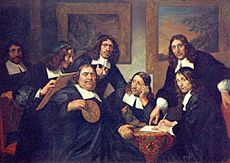 The Haarlem Painter's Guild in 1675, by Jan de Bray.
The Haarlem Painter's Guild in 1675, by Jan de Bray.
Like journey, the distance that could be travelled in a day, the title 'journeyman' derives from the French words for 'day' (jour and journée) from which came the middle English word journei. Journeymen were able to work for other masters, unlike apprentices, and generally paid by the day and were thus day labourers. After being employed by a master for several years, and after producing a qualifying piece of work, the apprentice was granted the rank of journeyman and was given documents (letters or certificates from his master and/or the guild itself) which certified him as a journeyman and entitled him to travel to other towns and countries to learn the art from other masters. These journeys could span large parts of Europe and were an unofficial way of communicating new methods and techniques, though by no means all journeymen made such travels - they were most common in Germany and Italy, and in other countries journeymen from small cities would often visit the capital.
After this journey and several years of experience, a journeyman could be received as master craftsman, though in some guilds this step could be made straight from apprentice. This would typically require the approval of all masters of a guild, a donation of money and other goods (often omitted for sons of existing members), and the production of a so-called masterpiece, which would illustrate the abilities of the aspiring master craftsman; this was often retained by the guild.
The medieval guild was established by charters or letters patent or similar authority by the city or the ruler and normally held a monopoly on trade in its craft within the city in which it operated: handicraft workers were forbidden by law to run any business if they were not members of a guild, and only masters were allowed to be members of a guild. Before these privileges were legislated, these groups of handicraft workers were simply called 'handicraft associations'.
The town authorities might be represented in the guild meetings and thus had a means of controlling the handicraft activities. This was important since towns very often depended on a good reputation for export of a narrow range of products, on which not only the guild's, but the town's, reputation depended. Controls on the association of physical locations to well-known exported products, e.g. wine from the Champagne and Bordeaux regions of France, tin-glazed earthenwares from certain cities in Holland, lace from Chantilly, etc., helped to establish a town's place in global commerce — this led to modern trademarks.
In many German and Italian cities, the more powerful guilds often had considerable political influence, and sometimes attempted to control the city authorities. In the 14th century, this led to numerous bloody uprisings, during which the guilds dissolved town councils and detained patricians in an attempt to increase their influence. In the early 14th century, some guilds in the cities of North-East Germany introduced statutes, under which persons of Wendish, i.e. Slavic, origin were forbidden from joining the guild.[14] According to Wilhelm Raabe, "down into the eighteenth century no German guild accepted a Wend."[15]
Fall of the guilds
As Ogilvie (2004) argues, the guilds negatively affected quality, skills, and innovation. They were control mechanism --or what economists now call "rent-seeking" and imposed deadweight losses on the economy. Ogilvie says they generated no demonstrable positive externalities and notes that industry began to flourish only after the guilds faded away. Guilds persisted over the centuries because they redistributed resources to politically powerful merchants. On the other hand, Ogilvie agrees, guilds created "social capital" of shared norms, common information, mutual sanctions, and collective political action. This social capital benefited guild members, even as they hurt outsiders.[16]
The guild system became a target of much criticism towards the end of the 18th century and the beginning of the 19th century. They were believed to oppose free trade and hinder technological innovation, technology transfer and business development. According to several accounts of this time, guilds became increasingly involved in simple territorial struggles against each other and against free practitioners of their arts.
Two of the most outspoken critics of the guild system were Jean-Jacques Rousseau and Adam Smith, and all over Europe a tendency to oppose government control over trades in favour of laissez-faire free market systems was growing rapidly and making its way into the political and legal system. The Le Chapelier Law of 1791 abolished the guilds in France, which it called corporations, according to Fernand Braudel.[17] Smith wrotes in The Wealth of Nations (Book I, Chapter X, paragraph 72):
- It is to prevent this reduction of price, and consequently of wages and profit, by restraining that free competition which would most certainly occasion it, that all corporations, and the greater part of corporation laws, have been established. (...) and when any particular class of artificers or traders thought proper to act as a corporation without a charter, such adulterine guilds, as they were called, were not always disfranchised upon that account, but obliged to fine annually to the king for permission to exercise their usurped privileges.
Karl Marx in his Communist Manifesto also criticized the guild system for its rigid gradation of social rank and the relation of oppressor/oppressed entailed by this system. From this time comes the low regard in which some people hold the guilds to this day. In part due to their own inability to control unruly corporate behavior, the tide turned against the guilds.
Because of industrialization and modernization of the trade and industry, and the rise of powerful nation-states that could directly issue patent and copyright protections — often revealing the trade secrets — the guilds' power faded. After the French Revolution they fell in most European nations through the 19th century, as the guild system was disbanded and replaced by free trade laws. By that time, many former handicraft workers had been forced to seek employment in the emerging manufacturing industries, using not closely guarded techniques but standardized methods controlled by corporations.
Influence of guilds
Guilds are sometimes said to be the precursors of modern trade unions, and also, paradoxically, of some aspects of the modern corporation. Guilds, however, were groups of self-employed skilled craftsmen with ownership and control over the materials and tools they needed to produce their goods. Guilds were, in other words, small business associations and thus had very little in common with trade unions. Guilds were more like cartels than they were like trade unions (Olson 1982). However, the journeymen organizations, which were at the time illegal[citation needed], may have been influential.
The exclusive privilege of a guild to produce certain goods or provide certain services was similar in spirit and character with the original patent systems that surfaced in England in 1624. These systems played a role in ending the guilds' dominance, as trade secret methods were superseded by modern firms directly revealing their techniques, and counting on the state to enforce their legal monopoly.
Some guild traditions still remain in a few handicrafts, in Europe especially among shoemakers and barbers. Some of the ritual traditions of the guilds were conserved in order organizations such as the Freemasons, alleging deriving from the Masons Guild. These are, however, not very important economically except as reminders of the responsibilities of some trades toward the public.
Modern antitrust law could be said to derive in some ways from the original statutes by which the guilds were abolished in Europe.
Modern guilds
Modern guilds exist in different forms around the world. In many European countries guilds have had a revival as local organizations for craftsmen, primarily in traditional skills. They may function as forums for developing competence and are often the local units of a national employer's organization.
In the United States guilds exist in several fields. The Screen Actors Guild, Writers Guild of America, East and the Writers Guild of America, West are capable of exercising very strong control in Hollywood because a very strong and rigid system of intellectual property rights exists. These guilds exclude other actors and writers who do not abide by the strict rules for competing within the film and television industry in America. The Newspaper Guild is a labor union for journalists and other newspaper workers, with over 30,000 members in North America.
Real estate brokerage is an example of a modern American guild. Signs of guild behavior in real estate brokerage include: standard pricing (6% of the home price), strong affiliation among all practitioners, self-regulation (see National Association of Realtors), strong cultural identity (see Realtor), little price variation with quality differences, and traditional methods in use by all practitioners. In September 2005, the U.S. Department of Justice filed an antitrust lawsuit against the National Association of Realtors challenging NAR practices that, DOJ asserts, prevent competition from practitioners who use different methods. The DOJ and the Federal Trade Commission in 2005 advocated against state laws, supported by NAR, that disadvantage new kinds of brokers.[18] U.S. v. National Assoc. of Realtors, Civil Action No. 05C-5140 (N.D. Ill. Sept. 7, 2005).
The practice of law in the United States is also an example of modern guilds at work. Every state maintains its own bar association, supervised by that state's highest court. The court decides the criteria for entering and staying in the legal profession. In most states, every attorney must be a member of that state's bar association in order to practice law. State laws forbid any person from engaging in the unauthorized practice of law and practicing attorneys are subject to rules of professional conduct that are enforced by the state's high court.
Medical associations that might be compared to guilds are the American Medical Association, and the American Dental Association.
Scholars from the history of ideas have noticed that consultants play a part similar to that of the journeymen of the guild systems: they often travel a lot, work at many different companies and spread new practices and knowledge between companies and corporations.
Many professional organizations similarly resemble the guild structure. Professions such as architecture, engineering, geology, and land surveying require varying lengths of apprenticeships before one can be granted a 'professional' certification. These certifications hold great legal weight and are required in most states as a prerequisite to doing business there.
Thomas W. Malone of the Massachusetts Institute of Technology champions a modern variant of the guild structure for modern "e-lancers", professionals who do mostly telework for multiple employers. Insurance including any professional liability, intellectual capital protections, an ethical code perhaps enforced by peer pressure and software, and other benefits of a strong association of producers of knowledge, benefit from economies of scale, and may prevent cut-throat competition that leads to inferior services undercutting prices.[citation needed] And, as with historical guilds, resist foreign competition. The free software community has from time to time explored a guild-like structure to unite against competition from Microsoft, e.g. Advogato assigns journeyer and master ranks to those committing to work only or mostly on free software.[citation needed]
In the City of London, the ancient guilds survive as Livery Companies, most of which play a ceremonial role. Guilds also survive in the UK in Preston, Lancashire as the Preston Guild Merchant where among other celebrations descendants of Burgesses are still admitted into membership. In 1878 the London Livery companies established the City and Guilds of London Institute the forerunner of the engineering school (still called City and Guilds college) at Imperial College London. The aim of the City and Guilds of London Institute was the Advancement of Technical Education. Today City and Guilds is an examining and accreditation body for vocational, managerial and engineering qualifications from entry level craft and trade skills up to post doctoral achievement.
In Australia, there exists the Guild of Commercial Filmmakers, a collection of commercial, short film and feature filmmakers.
In some online computer games, players can form groups called player guilds, wherein people can socialize and organize various in-game activities.
See also
- Guild of Saint Luke - Painter's Guilds
- Hanseatic League
- Jāti -guilds (of mediaeval origin) in India
- Trade union
- Timpani Guilds
- Guild socialism
- Catholic Police Guild
- Guild of St. Bernulphus
Notes
- ^ Hastings Rashdall, The Universities of Europe in the Middle Ages: Salerno. Bologna. Paris (1895) p. 150 online edition
- ^ Sheilagh C Ogilvie, "Rehabilitating the Guilds: A Reply," Economic History Review vol 61 (2008), 175–182
- ^ S. R. Epstein and Maarten Prak, eds. Guilds, Innovation and the European Economy, 1400–1800 (Cambridge University Press, 2008)
- ^ Stephan R. Epstein, "Craft Guilds, Apprenticeship, and Technological Change in Preindustrial Europe," Journal of Economic History, vol 58 (1998), 684–713.
- ^ Brockett, Oscar History of the Theatre: 8th Edition Needham Heights, 1999
- ^ Rouche, 1987 p 432.
- ^ Rouche, 1987 pp 431ff.
- ^ Viktor Ivanovich Rutenburg (1988). "Feudal society and its culture". Progress Publishers. p.30. ISBN 501000528X
- ^ Burton, E., & Marique, P. (1910). Guilds. In The Catholic Encyclopedia. New York: Robert Appleton Company. Retrieved December 12, 2010 from New Advent: http://www.newadvent.org/cathen/07066c.htm
- ^ Nicholas Shaxson: Treasure Islands, Tax Havens and the Men Who Stole the World; The Bodley Head, London, 2011.
- ^ L'Encyclopedie et les encyclopedistes. Centre international de synthese. p.366. ISBN 0833711571
- ^ Braudel 1982.
- ^ Braudel 1982, p. 316.
- ^ "The Situation with the Sorbs in the Past and Present" (pdf).
- ^ Raabe, p. 189.
- ^ Sheilagh Ogilvie, "Guilds, efficiency, and social capital: evidence from German proto-industry," Economic History Review, May 2004, Vol. 57 Issue 2, pp 286-333
- ^ Braudel 1982, p 314ff et passim
- ^ "U.S. v. National Association of Realtors". Usdoj.gov. http://www.usdoj.gov/atr/cases/nar.htm. Retrieved 2010-07-01.
References
- Braudel, Fernand: The Wheels of Commerce 1982, vol. II of Civilization and Capitalism
- Epstein, S. R. and Maarten Prak, eds. Guilds, Innovation, and the European Economy, 1400–1800 (2008) 360pp essays by scholars covering German and Italian territories, the Netherlands, France, and England; plus guilds in cloth spinning, painting, glass blowing, goldware, pewterware, book-selling, and clock making.
- Grafe, Regina, and Oscar Gelderblom. "The Rise and Fall of the Merchant Guilds: Re-thinking the Comparative Study of Commercial Institutions in Premodern Europe," Journal of Interdisciplinary History, Spring 2010, Vol. 40 Issue 4, pp 477–511. Comparative study of the origins and development of merchant guilds in Europe, esp. their emergence during the late Middle Ages and their decline in the Early Modern era
- Prak, Maarten a.o.: Craft Guilds in the Early Modern Low Countries: Work, Power and Representation. ISBN 978-0-7546-5339-4
- Rouche, Michel, "Private life conquers state and society," in A History of Private Life vol I, Paul Veyne, editor, Harvard University Press 1987 ISBN 0-674-39974-9
- Weyrauch, Thomas. Craftsmen and their Associations in Asia, Africa and Europe (Wettenberg/Germany, VVB Laufersweiler; 1999) ISBN 3-89687-537-X
Further reading
- Gordon Emery, Curious Chester (1999) ISBN 1-872265-94-4
- Liza Picard, Elizabeth's London (2003) ISBN 0-297-60729-4
- Lujo Brentano. On the History and Development of Gilds and the Origin of Trade-Unions Burt Frankin: Research & Source Works Series. New York: Burt Franklin, 1969.
- Steven Epstein, Wage Labor & Guilds In Medieval Europe (1991) ISBN 0-8078-4498-5
- Mancur Olson, The rise and decline of nations: economic growth, staglaction, and social rigidities (New Haven & London 1982).
- St. Eloy's Hospice, the last Guild House in Utrecht, Netherlands
- The Spacing Guild from the Dune series, created by Frank Herbert.
External links
- Medieval guilds
- St. Eloy's Hospice The last Guild House in Utrecht, Netherlands
Categories:- Crafts
- Economic history
- Labor
- Guilds
- Medieval economics
Wikimedia Foundation. 2010.

